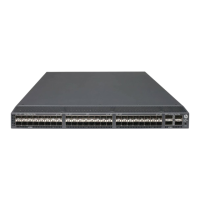129
Step Command Remarks
3. Configure the authentication
mode and authentication key
for an IPv4 VRRP group to
send and receive VRRP
packets.
vrrp vrid
virtual-router-id
authentication-mode
{
md5
|
simple
} {
cipher
|
plain
} key
By default, authentication is
disabled.
4. Configure the interval at
which the master in an IPv4
VRRP group sends VRRP
advertisements.
vrrp vrid
virtual-router-id
timer
advertise
adver-interval
The default setting is 100
centiseconds.
As a best practice to maintain
system stability, set the VRRP
advertisement interval to be
greater than 100 centiseconds.
5. Specify the source interface
for receiving and sending
VRRP packets.
vrrp vrid
virtual-router-id
source-interface
interface-type
interface-number
By default, the source interface
for receiving and sending VRRP
packets is not specified. The
interface where the VRRP group
resides sends and receives
VRRP packets.
6. Enable TTL check for IPv4
VRRP packets.
vrrp check-ttl enable
By default, TTL check for IPv4
VRRP packets is enabled.
7. Return to system view.
quit
N/A
8. Configure a DSCP value for
VRRP packets.
vrrp dscp
dscp-value
The DSCP value identifies the
packet priority during
transmission.
By default, the DSCP value for
VRRP packets is 48.
Configuring VF tracking
You can configure VF tracking in both standard mode and load balancing mode, but the function
takes effect only in load balancing mode.
In load balancing mode, you can establish the collaboration between the VFs and NQA or BFD
through the tracking function. When the state of the track entry transits to Negative, the weights of all
VFs in the VRRP group on the router decrease by a specific value. When the state of the track entry
transits to Positive or Notready, the original weight values of the VFs restore. If you configure the VF
tracking function on an LVF to monitor its corresponding AVF on a specified router, the LVF can take
over immediately when the status of the track entry becomes negative, to ensure uninterrupted
network communications.
Configuration guidelines
• By default, the weight of a VF is 255, and its lower limit of failure is 10.
• When the weight of a VF owner is higher than or equal to the lower limit of failure, its priority is
always 255 and does not change with the weight. To guarantee that an LVF can take over the
VF owner as the AVF when the upstream link of the VF owner fails, the reduced weight for the
VF owner must be higher than 245 so the weight of the VF owner can drop below the lower limit
of failure.
Configuration procedure
To configure VF tracking:
Step Command Remarks
1. Enter system view.
system-view
N/A

